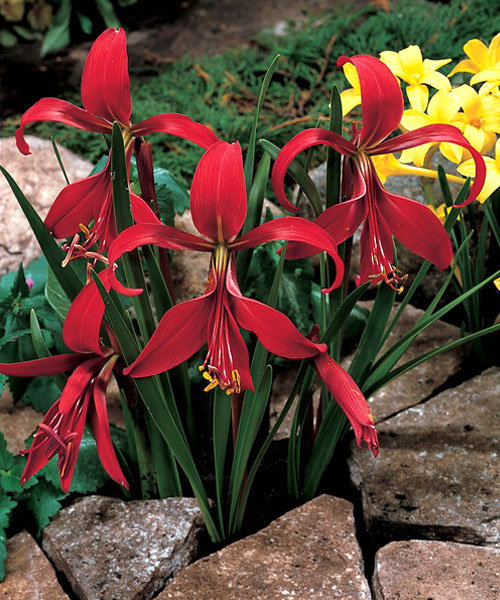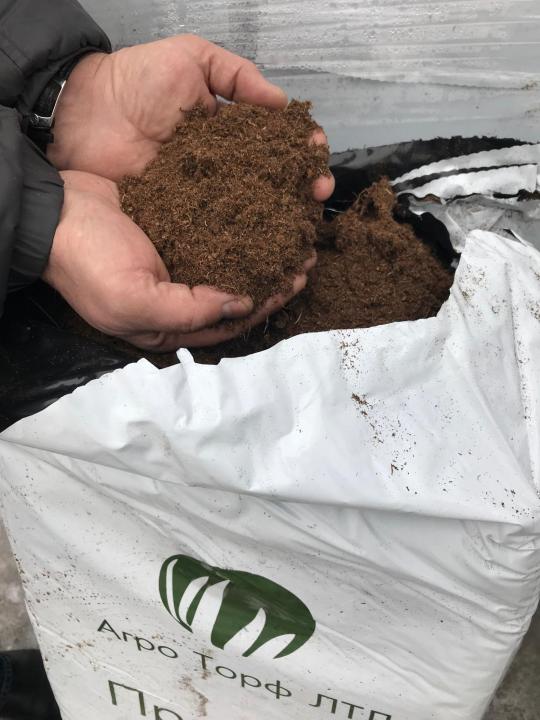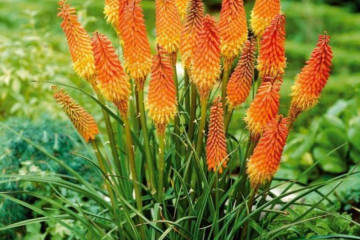Shprekelia - growing and care in the open field
Content:
Sprekelia belongs to the bright exotic plants. The splendor and grace of the unusual flowers are eye-catching. It will create coziness in the house and ennoble the dacha of shrekelia, the cultivation and care of which is within the power of novice florists.
Description of the plant
The catchy flower represents the Amaryllis family. There are 2 types of sprekelia: Formosissima (the most beautiful) and Howardii (magnificent). The plant is native to the mountainous regions of Mexico and Guatemala, where it is called the Aztec lily or Indian daffodil. During the festivities, the Aztecs decorated clothes and hair with flowers and hair.
The appearance of the Templar lily in Europe dates back to 1593, where it was brought by Spanish sailors.
The height of the bulbous culture reaches 30 cm. In an adult bulb, the diameter reaches 10 cm. The rich green foliage has a shiny surface, the shape is narrow, lanceolate. The length of the sheets is 40 cm, the width is 5 cm.
During flowering, a smooth, hollow red-brownish stem is formed, which is crowned with a large asymmetrical flower. 6 elongated petals curl intricately and form a beautiful shape.
The red color of the petals comes in different shades. Many elongated delicate stamens are covered with bright yellow pollen. Spreckelia smells good when it blooms. It looks like an orchid.
Sprekelia splendid is classified as a thermophilic crop, it is afraid of the cold. The plant is considered a perennial, but in the average Russian strip it is grown as an annual without special care.
Popular plant varieties:
- Karwinskii. The crimson petals have a white border.
- Peru. The flowers have an intense red color.
- Orient Red. The red petals are characterized by white longitudinal blotches.
Sprekelia varieties bloom in May or early June for 3-4 weeks. If you take care of the flower correctly, it will delight you with re-flowering in September.
Home and outdoor care
Pot for sprekelia
To grow a plant, choose the right pot. A container with a diameter of 3 cm larger than the diameter of the bulb of the spreckel is ideal.
The creation of drainage using gravel, expanded clay, broken brick is appreciated.
When a crop grows in a cramped flowerpot, it blooms faster. A wider vessel will be required to form daughter onions.
Soil and fertilizer
Distinctive features of the soil for a flower are lightness, looseness, water permeability. The pH level is 5.5-6.5.
Newbie flower growers can use a purchased soil mixture. If desired, prepare the substrate yourself using:
- turf - 2 parts;
- sand, humus, peat - 1 part each.
Add sphagnum moss, pine bark, charcoal.
When planting in a pot, the bulb is buried halfway into the soil. They feed the spreckel when a peduncle is formed. Top dressing is applied every 2 weeks until the end of the summer season. They use fertilizers for flowering crops.
Humidity and watering
Sprekelia arranges dry air in the room, there is no need to humidify and spray the plant additionally.
In spring and summer, the flower needs intense and abundant watering. It is preferable to moisten the sprekelia in a tray or along the edge of the container. Do not allow water to enter the bulb and foliage. The transition to a dormant state is accompanied by a reduction in watering.
When the leaves dry out, the moistening is completely suspended. They do not allow moisture to stagnate in the flowerpot and do not overmoisten the soil. Excess moisture is responsible for the rotting of the root bulb and the death of the plant.
Temperature and illumination
When a culture is actively growing and blooming, it will need temperature support. This period falls during the warm season and is without problems for sprekelia. A suitable temperature for a flower is + 22 ... + 25 ° С.
With the onset of winter, a dormant period begins, which is characterized by a decrease in temperature to + 16 ... + 18 ° С.
Sprekelia needs a lot of light. In addition, in the evening and in the morning, the plant will need direct rays of the sun for at least 4 hours. At home, a place for a flower is chosen by the windows that face east, west and south. For uniform growth of leaves, the flowerpot is turned.
The culture does not like the location on the northern windows. A lack of light leads to stretching of the sheets, loss of color and a decrease in the decorative effect of the spreckel.
On the south side, it is useful to protect the sprekelia from the scorching sun at noon. This applies to plants in open beds. In addition, the culture is protected from wind and drafts.
Pruning
Manipulation is carried out after the plant has faded. The peduncle is cut at a height of 3 cm from the bulbous neck. When the ground part of the sprekelia dies off, the bulbs are dug up and the dried foliage is cut off.
Flower reproduction methods
The flower is propagated by the seed method and by baby bulbs.
How to plant an onion
Daughter bulbs, which are formed at the bottom of an adult, are planted. For planting, 3 cm onions with small roots are suitable.
Use a knife to separate the onions. The cut site is disinfected with activated carbon. The planting material is planted in separate containers.
The procedure falls on March. You will need a fresh soil mixture. The onion is not completely buried: the upper lobe and neck are opened. Watered little by little. The formation of flower arrows is a signal to increase moisture. Top dressing is added to the water.
Planting of bulbs on flower beds in spring is possible.
Growing from seeds
If a crop is grown from seeds, the process is laborious. The collection of seeds is carried out in the middle of autumn. With the onset of spring, the seed is planted in containers with moistened fertilized soil.
When seedlings appear and strengthen, they are seated at intervals of 10-15 cm from each other. Strengthened shoots are planted in unprotected soil. Plants grown from seeds bloom only in the third year of life. Sprekelia is actively working on the formation of a full-fledged tuber.
Seed material of sprekelia is obtained after manual pollination of the plant. Seed propagation is not responsible for maintaining varietal qualities. Fresh seeds sprout for 3 weeks, sowing is not delayed, they are carried out immediately after collection. Seed material loses germination within 5 weeks.
Seeds are scattered over the soil surface and sprinkled a little. The temperature regime is + 22 ... + 25 ˚С, humidity maintenance is required. When 3 leaves appear, young onions are transplanted into individual containers.
Transplant rules for growing outdoors
In the country, the plant is grown as an annual, at home - up to 5 years.
When breeding sprekelia, cultivation and care in the open field provide for the observance of certain requirements:
- buying onions shortly before disembarkation;
- selection of an area illuminated by the sun, without drafts and stagnant water, with loose fertile soil;
- planting seed in March-May.
When landing, use the following scheme:
- deepening of the onions - 10 cm;
- the minimum distance between the bulbs is 10 cm.
The plantings are mulched with peat. When the plants are cultivated in cold climates, the bulbs are dug up after the end of the growing season.
The final dying off of the leaves signals the digging and cleaning of soil and dried tops. It is forbidden to cut the roots on the bulbs.
Keep the bulbs cool in dry peat.
Exceeding the temperature of +10 ° С gives rise to germination ahead of time.
Flower care during dormancy
Sprekelia has a long resting period. It is half a year: it starts in November and ends in March. A flower is prepared for it with the arrival of autumn, gradually reducing watering. When the last leaf disappears, the plant is not watered. The sprekelia onion is left in a flowerpot, the container is placed in a dry, cool room with a temperature in the range of + 16 ... + 18 ° C.
If desired, the onion is taken out of the pot, transferred to a container with dry peat and taken out into the cool (+ 12 ... + 13 ° C) until the end of the winter season. With the arrival of spring, the bulbs are again planted in a flowerpot. Moistening of the culture is resumed when the peduncle is formed.
If you plan to decorate an apartment, office, greenhouse or personal plot, a magnificent spreckelia will help out, planting and caring for which will not be difficult. An exotic plant will delight you with bright flowers and a pleasant aroma in mono-plantings and in combination with other garden plants.























